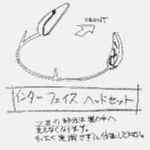Interface Headset: Difference between revisions
(Somebody please kill the A10 stuff; the A10 nerve is in the brain stem......) |
No edit summary |
||
| (15 intermediate revisions by 5 users not shown) | |||
| Line 1: | Line 1: | ||
{{ | {{needpics}} | ||
[[Image:InterfaceHeadset.gif|right]] | [[Image:InterfaceHeadset.gif|right]] | ||
An '''interface headset''' is an device | An '''interface headset''' (インタフェイスヘッドセット, ''intāfēsu heddosetto'') is an device worn on the head of an [[Evangelion]] pilot. | ||
The primary model of interface headset is composed of a thin, hairband-shaped wire linking two small pods. The wire section is nestled beneath the pilot's hair and is thus always obscured from view, making it appear as if the headset is comprised of two separate devices clipped on top of the head. The name suggests that the interface headset plays some role in the Eva-pilot interface, but exactly what is never elaborated upon. | |||
The headsets used by [[Asuka Langley Soryu]], and by [[Asuka Shikinami Langley]] for her [[Evangelion Unit-03|Eva-03]] test, are both more similar to hair clips in form than the default model. [[Mari Makinami Illustrious]] also wears a unique model incorporated into a hairband. For both Asuka and Mari, the headset lies against different parts of the brain than the standard model, but whether this has any functional implications isn't known. | |||
During the course of the show, pilots have been sent into an Eva without a [[plugsuit]], whereas an interface headset has in most cases been worn, implying that it is a more critical piece of equipment. The only times the headsets are not used is during the [[Simulation Bodies|simulation body]] tests in [[Episode 13]], and most notably by [[Shinji Ikari|Shinji]] during [[Eva-01|Eva-01's]] final sortie in the [[End of Evangelion]]. In both instances, the pilots do not display very much conscious control over the units in question. More mundanely, the entry plug holographic HUDs do not appear either. | |||
== | ==="A10 Nerve Clips"=== | ||
The interface headset is better known in the English-speaking fan community by "A10 nerve clips" than by its official designation. The nickname is quite misleading, as not only is Asuka's headset the only one qualifying as "clips", nothing in the show or supplemental materials (including the frequently mis-cited theatrical booklets) suggests that they play a direct role in A10 nerve synchronization. | |||
[[Category:A to Z]] | |||
[[Category:Terminology]] | [[Category:Terminology]] | ||
Latest revision as of 14:43, 22 June 2013

|
They say a picture is worth a thousand words... |

An interface headset (インタフェイスヘッドセット, intāfēsu heddosetto) is an device worn on the head of an Evangelion pilot.
The primary model of interface headset is composed of a thin, hairband-shaped wire linking two small pods. The wire section is nestled beneath the pilot's hair and is thus always obscured from view, making it appear as if the headset is comprised of two separate devices clipped on top of the head. The name suggests that the interface headset plays some role in the Eva-pilot interface, but exactly what is never elaborated upon.
The headsets used by Asuka Langley Soryu, and by Asuka Shikinami Langley for her Eva-03 test, are both more similar to hair clips in form than the default model. Mari Makinami Illustrious also wears a unique model incorporated into a hairband. For both Asuka and Mari, the headset lies against different parts of the brain than the standard model, but whether this has any functional implications isn't known.
During the course of the show, pilots have been sent into an Eva without a plugsuit, whereas an interface headset has in most cases been worn, implying that it is a more critical piece of equipment. The only times the headsets are not used is during the simulation body tests in Episode 13, and most notably by Shinji during Eva-01's final sortie in the End of Evangelion. In both instances, the pilots do not display very much conscious control over the units in question. More mundanely, the entry plug holographic HUDs do not appear either.
"A10 Nerve Clips"
The interface headset is better known in the English-speaking fan community by "A10 nerve clips" than by its official designation. The nickname is quite misleading, as not only is Asuka's headset the only one qualifying as "clips", nothing in the show or supplemental materials (including the frequently mis-cited theatrical booklets) suggests that they play a direct role in A10 nerve synchronization.
